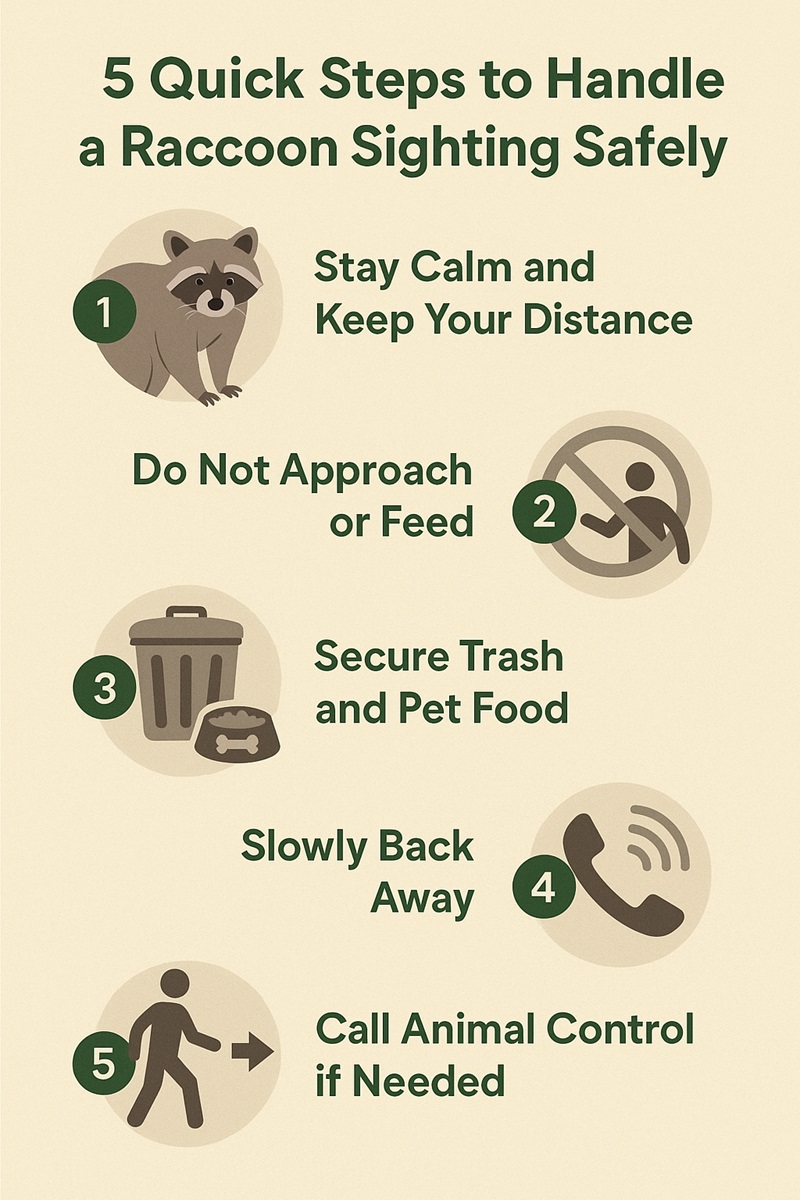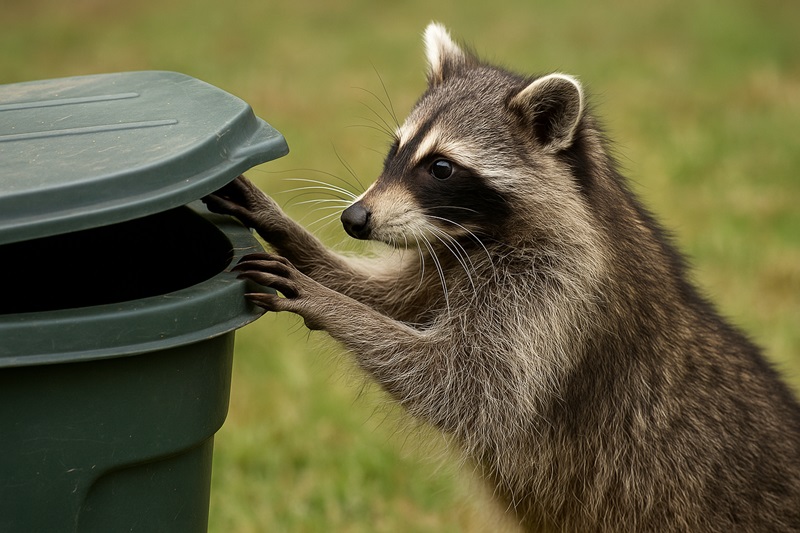Quick Answer: Are Raccoons Dangerous?
Raccoons are usually curious, not dangerous, but they can become a threat if they feel cornered, carry disease, or show aggressive behavior. Watch for signs like stumbling, drooling, or daytime activity, and keep a safe distance if you spot one.
If you’ve ever spotted a raccoon wandering through your yard or campsite, you’ve likely asked yourself: are racoons dangerous, or just curious? Their masked faces and dexterous little paws can look charming, but they can also spark concern — especially for families with pets or small children.
Understanding their behavior is the first step to knowing when a raccoon is a harmless visitor and when it might be time to take action.
Why Raccoons Visit Yards, Porches, and Campsites
Raccoons don’t wander into human spaces by accident — they come looking for easy food and shelter. Understanding what attracts them helps you prevent unwanted visits without harming wildlife.
What Brings Raccoons to Your Property
- Trash and compost → Open or lightly sealed bins are an irresistible buffet.
- Pet food bowls → Cats and dogs often leave scraps behind.
- Bird feeders → Spilled seeds attract both raccoons and the small animals they hunt.
- Overripe garden produce → Tomatoes, berries, and corn are raccoon favorites.
- Shelter → Gaps under decks, sheds, attics, or crawl spaces make warm nesting spots.
- Water sources → Ponds, kiddie pools, dripping hoses, or outdoor bowls provide hydration.
Why This Matters for Safety
A raccoon close to your home is usually driven by hunger, not aggression — but the closer they come, the higher the chance of defensive encounters with pets or humans.
Understanding Raccoon Behavior
Raccoons are nocturnal, intelligent, and highly adaptable mammals that thrive anywhere they find food and shelter. They’re most active from dusk to dawn, scavenging for fruit, insects, eggs, and — quite often — the contents of your garbage can.
In suburban and rural areas, raccoons are drawn to pet food bowls, compost piles, and uncovered trash. Their curiosity drives them to explore porches, sheds, and even attics if they can find an entry point.
Most raccoons are inquisitive rather than aggressive. When left alone, they prefer to flee rather than fight. However, that curiosity can sometimes lead to unwanted damage — or, in rare cases, defensive behavior.
Fun fact: Raccoons can remember solutions to complex problems for up to three years — that’s smarter than most dogs!
What Attracts Raccoons (And How to Remove These ‘Magnets’)
Most raccoon problems start with small, unintentional invitations.
Common Raccoon Magnets
| Magnet | Why It Attracts Them | Fix |
| Overflowing trash bin | Easy, calorie-dense food | Use locking lids / metal bins |
| Pet food outdoors | Reliable nightly snack | Feed pets indoors |
| Fallen fruit | Natural sugars | Rake yard daily |
| Uncovered compost | Warm, smelly, full of nutrients | Use sealed composting systems |
| Open sheds/attics | Safe nesting | Patch and lock entries |
A few small adjustments dramatically reduce raccoon visits.

Healthy vs. Sick Raccoon
A raccoon’s behavior and physical condition reveal more than you think. Here’s a fast way to interpret what you’re seeing:
Signs of a Healthy Raccoon
- Moves smoothly and reacts quickly
- Avoids people and prefers to hide
- Fur looks clean and flat
- Tail is relaxed
- Eyes are bright and alert
- Sniffs, pauses, and investigates cautiously
Signs of a Potentially Dangerous or Sick Raccoon
- Wandering in circles or stumbling
- Slow or “drunk-like” movements
- Foaming, drooling, or open-mouth breathing
- Matted fur or visible wounds
- Hissing, growling, or charging without provocation
- Appearing dazed or “out of it” during the day
If you see more than one danger sign, behave as though the animal is sick and call local wildlife control.
Raccoon Appearance and the Body Parts That Signal Danger
At first glance, raccoons look almost playful — with their black “bandit mask,” ringed tail, and nimble paws. But behind that adorable exterior, several features can signal whether a raccoon is harmless or potentially dangerous. Knowing what to look for helps you interpret their mood and stay safe around them.
Eyes: Alert or Glazed Over
Healthy raccoons have bright, alert eyes that constantly scan their surroundings.
If you see eyes that appear glazed, unfocused, or droopy, that can indicate illness, exhaustion, or infection — especially if the raccoon is out during the day. Cloudy eyes and slow blinking often accompany rabies or distemper.

Teeth and Mouth: A Key Danger Zone
Raccoons have sharp canine teeth capable of breaking skin easily. Growling, showing teeth, or excessive drooling or foaming are clear warning signs of defensive or diseased behavior.
Never approach a raccoon displaying these symptoms — rabies often affects salivation and jaw control.
Paws and Claws: Surprisingly Strong
Raccoons’ front paws are incredibly dexterous, similar to human hands. They can grip, twist, and open containers, which makes them resourceful but also destructive. Their claws are sharp enough to tear open wood, insulation, or pet enclosures.
If you find deep scratch marks around garbage lids or chicken coops, a raccoon might be testing your defenses.
Tail and Fur: Signs of Mood
A fluffed or bristled tail signals stress or fear — just like a cat’s defensive posture. Smooth, relaxed fur usually means the raccoon is calm.
Watch for arched backs or rapid tail flicking — these are early indicators that the animal feels threatened and may lash out.
Overall Posture: Reading the Body Language
- Crouched with raised shoulders → Defensive, preparing to attack or flee.
- Standing tall or swaying side to side → Intimidation display.
- Slow-moving or staggering → Potential neurological illness.
- Quick darting motions → Curiosity, not aggression.
Tip: Keep a safe distance of at least 20–30 feet. Even a small raccoon can scratch or bite if cornered.
While raccoons are naturally curious, their body language and visible health signs tell you everything you need to know. Bright eyes, smooth fur, and cautious movements usually mean a healthy, harmless visitor. But drooling, aggression, or disorientation are warning signs to stay back and call wildlife control.
When Curiosity Turns Risky — Warning Signs a Raccoon Might Be Dangerous
A calm raccoon wandering by isn’t automatically a threat. But certain behaviors signal possible disease, aggression, or distress — and those require caution.
1. Active During Daylight
Healthy raccoons are nocturnal. Daytime activity can sometimes indicate rabies, distemper, or injury, though nursing mothers may appear during the day while searching for food.
2. Aggressive or Fearless Behavior
Growling, hissing, or charging toward humans or pets suggests defensiveness or illness. A healthy raccoon normally retreats when approached.
3. Disoriented or Stumbling Movements
Wobbling, falling over, or walking in circles are red flags of neurological illness like rabies or canine distemper.
4. Excessive Drooling or Visible Wounds
These can indicate infection or injury — both reasons to keep your distance and call local animal control.
5. Protective Mothers
If you spot a raccoon family, the mother may hiss or lunge to protect her young. Back away slowly; once she feels safe, she’ll move her kits elsewhere.
What To Do If a Raccoon Approaches You
Most raccoons flee when they notice a human, but if one moves toward you, stay calm.
Follow These Steps
- Stand tall and make yourself visible. Sudden movements may startle the raccoon.
- Speak firmly or clap. Most raccoons retreat when they realize you’re not prey.
- Back away slowly. Do not turn and run — fast movement can trigger chasing.
- Put a solid object between you and the raccoon (chair, cooler, backpack).
- Get inside if possible. Close the door behind you to let the raccoon pass.
When It’s Serious
Call animal control if the raccoon:
- ignores your presence
- shows no fear
- moves toward you stiffly or erratically
- acts confused or aggressive
These can be signs of illness such as rabies or distemper.
Are Racoons Dangerous to People and Pets?
Raccoons rarely attack humans unprovoked, but they can still pose health and safety risks.
To People
- Rabies: Though uncommon, raccoons are one of the main wildlife carriers of rabies in North America. Any bite or scratch should be treated as serious — seek medical care immediately.
- Leptospirosis and Parasites: Raccoon feces can carry roundworm eggs and bacteria that cause leptospirosis, a disease spread through contaminated soil or water.
To Pets
- Dogs or cats may chase raccoons, triggering defensive attacks.
- Contact with raccoon saliva or feces can expose pets to diseases.
- Secure pet food and water bowls indoors to reduce temptation.
If your pet is bitten or scratched, contact your veterinarian right away for post-exposure care.
Myths vs. Facts — Debunking Common Raccoon Misconceptions
| Myth | Reality |
| All raccoons have rabies. | Only a small percentage are infected; most are healthy and avoid humans. |
| Raccoons only live in forests. | They adapt easily to cities, suburbs, and even coastal areas. |
| Raccoons attack people on sight. | They prefer to flee unless cornered, sick, or protecting young. |
| Raccoons are harmless if friendly. | “Friendly” raccoons may be sick or have been fed by humans, which makes them risky. |
What to Do If You See a Raccoon in Your Yard
If you see a raccoon in your yard, stay calm, keep your distance, and remove any food sources. Most raccoons will leave on their own once they realize there’s nothing to eat.
Raccoons don’t need to be feared — but they should be respected. If one visits your yard:
- Stay calm and keep distance. Don’t yell or chase it; that can trigger aggression.
- Avoid feeding. Feeding encourages dependency and bold behavior.
- Secure trash bins. Use wildlife-proof lids or metal cans.
- Remove attractants. Bring pet food indoors and clean up fallen fruit.
- Close entry points. Seal gaps under decks, attics, or sheds.
- Call professionals if necessary. If the raccoon appears sick, trapped, or aggressive, contact local animal control or a licensed wildlife rehabilitator.
How to Safely Scare Away a Raccoon
If a raccoon gets too close for comfort, you can discourage it without putting yourself or the animal at risk.
Effective, Humane Ways to Deter Raccoons
- Make noise: Clap, speak firmly, or tap objects to alert them of your presence.
- Use motion lights: Sudden light startles raccoons and teaches them to avoid the area.
- Turn on sprinklers: A short burst of water is safe but extremely effective.
- Remove food sources: Clean up fallen fruit, store pet food indoors, secure waste.
- Use scent-based deterrents: Vinegar, peppermint oil, and ammonia-soaked rags can help keep them away (use ammonia outdoors only).
- Block access: Secure decks, vents, chimneys, and roof gaps.
What Not to Do
- Don’t chase or corner them.
- Don’t throw objects.
- Never use poison or harmful chemicals — illegal and dangerous.
- Don’t try to “scare” mother raccoons with babies — they may defend aggressively.
Prevention Tips for Homeowners and Campers
For Homeowners
- Lock trash bins and compost securely.
- Feed pets indoors and store food in sealed containers.
- Install motion-sensor lights or sprinklers to discourage night visitors.
- Trim tree branches near your roof to block attic access.
- Seal vents, chimneys, and crawl spaces.
For Campers and Outdoor Enthusiasts
- Store food and waste properly using raccoon-proof containers or hanging bags.
- Avoid feeding wildlife, even out of curiosity.
- Clean campsites nightly — raccoons have an excellent memory for easy meals.
- Stay calm if one approaches — clap or make gentle noise to scare it away.
When to Seek Professional Help
You should call a wildlife expert or animal control if:
- A raccoon shows signs of illness (stumbling, drooling, aggression).
- You notice repeated visits despite prevention efforts.
- You find a raccoon trapped in a chimney, attic, or crawl space.
- You or your pet experience a bite, scratch, or close encounter.
Never attempt to capture or relocate raccoons on your own — it’s illegal in many areas and can lead to injury.
Final Thoughts — Respecting Wildlife, Protecting Your Space
Most raccoons are simply curious survivors, adapting to our neighborhoods as natural habitats shrink. They aren’t villains — but like any wild animal, they deserve space and caution.
By understanding raccoon behavior, securing your property, and reacting calmly to encounters, you can coexist safely without harm to you or the animal.
Takeaway: “Raccoons aren’t out to hurt you — they just want your leftovers. Respect their space, and they’ll respect yours.”
FAQ
Q: Are raccoons dangerous to humans?
A: Not usually. They avoid people, but bites and scratches can transmit rabies or other infections.
Q: Are raccoons dangerous to pets?
A: Yes, they can harm pets if cornered or threatened. Keep pet food inside and monitor outdoor animals.
Q: What diseases do raccoons carry?
A: Rabies, roundworms, and leptospirosis are the main health risks associated with raccoons.
Q: What should I do if bitten by a raccoon?
A: Wash the wound immediately, then seek medical attention for rabies evaluation and treatment.







